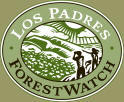|
May 13, 2005
ADMINISTRATION ELIMINATES
PROTECTIONS
FOR PRISTINE,
ROADLESS AREAS
Decision
Threatens 636,000 Acres of Wildlands
in the Los Padres National Forest
Washington, D.C. - Today, the
Administration published its final plans to overturn the
popular Roadless Area Conservation Rule. The new regulation
eliminates protections for over 58.5 million acres of roadless
wildlands across the nation, placing the country's last
remaining untouched forests at risk to new road
construction and development.
"This new policy means that over
one-third of the Los Padres National Forest may now be opened to
new and destructive activities, like oil and gas drilling," said
Jeff Kuyper, Executive Director of Los Padres ForestWatch. The
Forest Service is finalizing its plans to allow oil and gas
drilling across up to 140,000 acres of the Los Padres, 70% of which
are currently roadless lands.
Roadless forests offer solitude and primitive recreation
experiences such as hiking, backpacking, horseback riding,
hunting, fishing, and rockclimbing. These areas are also an
essential source of clean drinking water and support large
blocks of undisturbed habitat.
The original roadless rule, implemented in 2001, provided
automatic protection for all roadless areas across the country. The Administration's new rule
overturns these nationwide protections and replaces them with an
optional three-step process. First, the governor of any state
can petition the
Secretary of Agriculture (a political appointee) to adopt
regulations for management of any roadless area in the state.
Second, the Secretary must then decide whether to accept or
reject the state's petition. Third, if the Secretary accepts the
governor's petition, the Forest Service must initiate a lengthy
rulemaking process for that particular state.
This new petition process
could leave many areas, and perhaps entire states, without any
roadless protections. Any
petition submitted by a governor will be reviewed by political
appointees who may accept or reject the proposal. Even if a
petition is accepted, the outcome of the subsequent
state-specific regulations is still uncertain, and may result in
regulations that are weaker than those proposed by the state. In
its explanation of the new rule, the Administration emphasizes
that "there is no guarantee" that a state's proposals will
actually be adopted. In a
last-minute change, the Administration will require the creation
of an Advisory Committee made up of 12 representatives to give
advice and recommendations to the Secretary of Agriculture on
implementing the state petition process. The committee will
review each State petition and make its recommendations.
However, Advisory Committee members will be hand-picked by the
Secretary of Agriculture, and the Secretary is under no
obligation to follow the committee's advice.
These changes disregard the wishes
of millions of Americans who have repeatedly said they want
these special places preserved. During the creation of the
original roadless rule, more than two million citizens voiced
their support for the protection of roadless areas, ten times
more than any other federal rule in history. The new rule
overturns these protections and disregards the public's wishes
to permanently preserve these special places.
America's national forests are
currently covered with 440,000 miles of roads, enough to circle
the globe 17 times.
The Forest Service currently has an $8.4 billion backlog in
maintaining these roads. "The
Forest Service should not be opening up pristine areas to roadbuilding when the agency doesn't even have sufficient funds
to maintain existing roads," said Kuyper.
Many of these roads negatively impact the health of our public lands.
They fragment wildlife habitat, degrade water quality and fish
habitat, and increase erosion and sedimentation into streams,
lakes, and rivers. Roads contribute more sediment into streams
than any other activity on public lands.
The Los Padres
contains 37 inventoried roadless areas totaling 636,000 acres,
the second-highest in California. Along the eastern edge of the
Los Padres, the Antimony Mountain roadless area provides
commanding views of the southern Sierra Nevada range and is a
vital wildlife corridor to the Carrizo Plain National Monument. Several roadless areas surrounding the Sespe Wilderness contain
fascinating geologic formations, and are classified as areas of
high ecological significance. The Badlands and Abel roadless
areas support rare endemic species and are considered sacred by
the native Chumash.
# # # |

